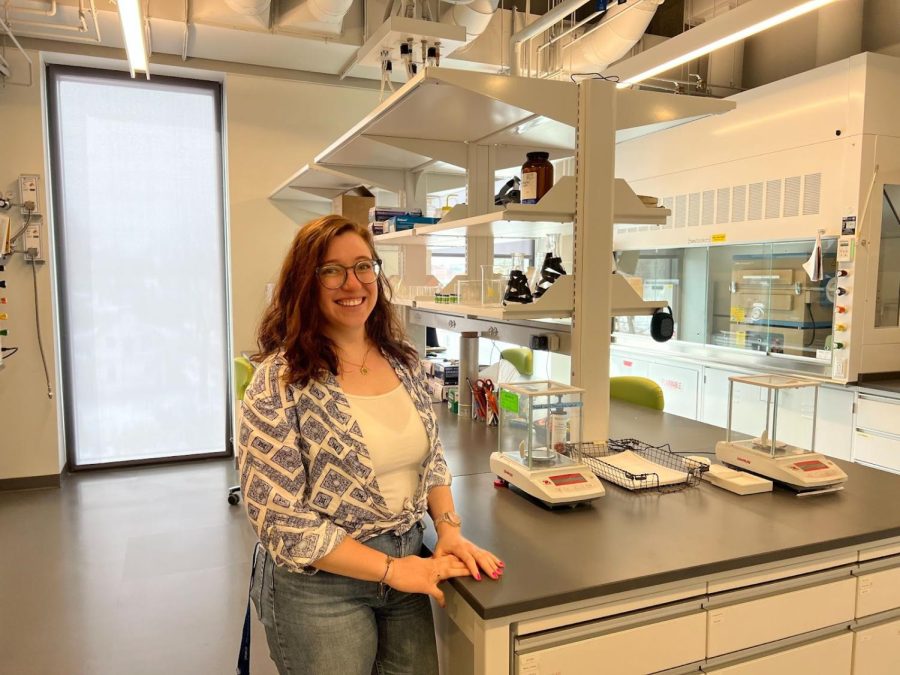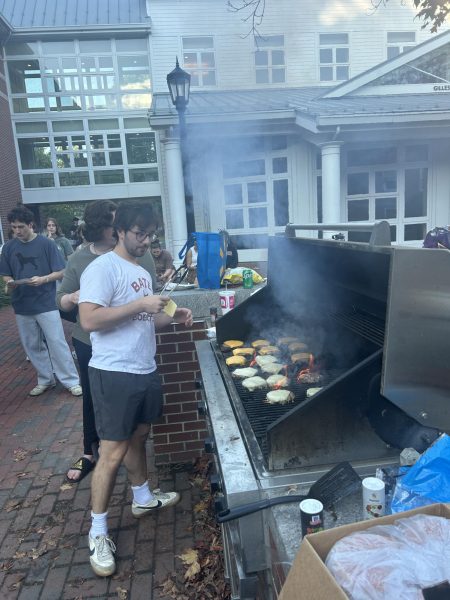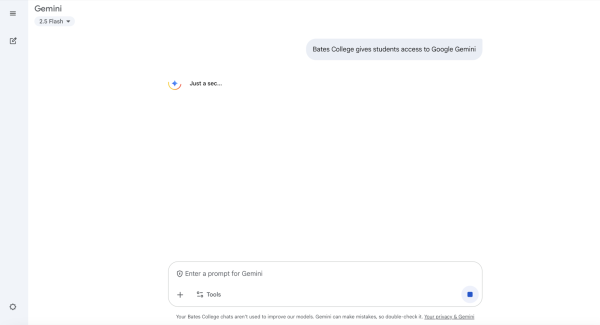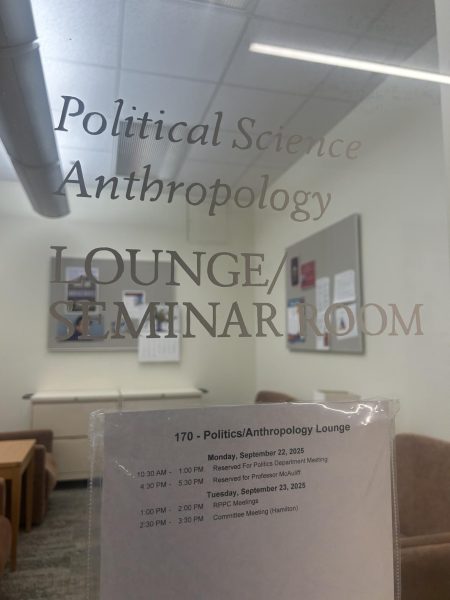Q&A with Geneva Laurita, Professor of Chemistry and Biochemistry, on her NSF CAREER award
Assistant Professor of Chemistry and Biochemistry Geneva Laurita was recently awarded a National Science Foundation CAREER award of $582,000. The award is given to early-career/junior faculty who not only have the ability to conduct high-impact research but have the potential to serve as educational leaders.
Laurita is only the second faculty member in Bates College history to receive the award after Associate Professor of Neuroscience Jason B. Castro in 2016. She sat down with The Bates Student to recount her story and future path with the grant.
What drew you to Bates? What appeals did the chemistry department have for you?
“The thing that really made me feel very excited was this idea of just undergraduate research and undergraduate teaching and mentoring. For me, I had my very first experiment in a national lab when I was an undergrad. I wanted to be able to provide those kinds of transformative research experiences at an undergraduate level, particularly working with the national labs. […] When I interviewed here, the department had a good feel to it and Bates has a great reputation […] there’s a lot of wonderful things about Bates.”
I know your career is still relatively young, but please discuss your career and research path. Where did it start and where did it taper off before the NSF CAREER award?
“The CAREER Award actually kind of launches off of a lot of the research that we did in my first couple of years here. I actually have a current NSF grant that’s just ending and they (NSF CAREER award) kind of overlap. A lot of the ideas from the CAREER grant came out of some of the stuff that we had discovered. We are always working on this idea of structure-property relationships. So, how does structure influence what kind of (chemical) properties you have? But […] crystal structure and these pyrochlores that I’m working with have always kind of been a little bit of a pet project of mine. I started working on them a little bit in grad school, and I didn’t work on them much during my postdoc, but it’s always been my favorite crystal structure type. […] It’s really just like a continuation or really building off of a lot of the stuff that was done by Bates students within my first five years here.”
Was an interest in crystal structures what made you go into chemistry as an undergrad or grad student? If not, what did?
“I think it’s not what made me go into it, but it is definitely what’s kept me in it. When I started, I just really remember in high school […] this idea that you can organize chemistry and (chemical) behavior. […] That was kind of like what got me interested in it. (In college) I actually didn’t love gen chem when I took it. It was a big lecture, and it just didn’t have a very good narrative. […] I wanted to be a music major for a while, and then I decided to go into pre-pharmacy. I was actually just going to do undergrad for two years, and then go straight into pharmacy school, but then my organic (chemistry) professor told me to try some research, maybe finish out my chemistry degree, and then go to pharmacy school. […] So I ended up staying, sticking around to inorganic chemistry. There, I just kind of found the things I really loved. I remember when we talked about superconductors in that class, I was like, “this is the coolest thing I’ve ever heard of.” […] Then when I did neutron experiments and got into crystallography, that’s when I was like, “Ah, this is really it.” So it just kept building upon itself.”
Moving into the realm of your CAREER award, how does it differ from your current and past NSF grants?
“My current NSF grant is just a normal project (grant), so anybody can apply to it. […] The thing that’s really different about a CAREER grant is that it is specifically designed for an early career researcher to kind of launch their mid-career. It also has to have a specific educational component with it, and this is in addition to broader (research) impacts. So not only do you have to have a scientific project that you’re working on, you have to have an educational project as well. Mine is where I’m basically doing kind of like a little bit of an undergrad-institution internship for graduate students. […] I’ll be bringing graduate students out to Bates College so that they can see what it’s like to hands-on teach, and do research with undergraduates. This is also a five-year grant whereas the regular single PI (principal investigator) is usually three years.”
In terms of your research, what direction will it take under the grant?
“We’re looking at materials for sustainable energy and electronic applications. One of the big issues is that a lot of the electronics that we use have things like lead or really expensive metals […]. With that in mind, the first grant was just trying to find lead-free electronics. So this is thinking about just manipulating electric dipoles into the material. But now, we’re kind of expanding it. What if we have an electric dipole and a magnetic dipole? How can we get those things to interact? Because the more things you have in your structure that you can tune with external stimuli, the more options it has to be used in technological devices.”
Are CAREER awards typically awarded to faculty at small liberal arts colleges such as yourself?
“Not typically, no. […] When you’re evaluated for a CAREER grant, you’re thrown into the whole pool with everybody. You’re evaluated against all of these other (faculty from) R1 research institutions. And it’s tough for those from private, smaller liberal arts colleges or PUIs (primarily undergraduate institutions) because a lot of both the science and the educational components do require a certain amount of infrastructure. I think that as a PI, as the person who’s writing this grant, you have to be really thoughtful and intentional about what you can do with your institution. The reason I can do a lot of this research is because I use the national labs.”
How did you feel when you got the grant?
“I was super excited, super surprised, and a little terrified. All of these different feelings.”
We brushed upon this briefly before, but a lot the NSF has a lot of dialogue on an awardee’s potential as an educator. What is your mission or goal as a teacher/mentor?
“If I had to distill it down, I want students to be able to see their potential. […] I think anybody can do chemistry, and I want to be able to help students discover what’s the best way to do chemistry for them. I also want them to be able to see how chemistry can help them down the road, even if they’re not planning on having a career in it.”
Ideally, where do you see yourself in the next 5 years with the grant?
“Hopefully I’m in a really different spot. I think the worst outcome would be if I was doing exactly the same thing that I’m doing right now. […] With the research, hopefully, we’ll find some cool stuff that people can use. […] I’ve also been able to take students out to national labs, we’ve had a lot of travel, and we’ve had a lot more networking. So I’m hoping that my network is a bit bigger, and I hope that the undergraduates’ network is a bit bigger as well, and just seeing where everybody ends up after they do these things. I’m hoping every time I do more research and broaden my research field, I can think about ways that I can tie that into my teaching. And more experience for me means that I can bring that back to the classroom and expose students to that as well.”
Your donation will support the student journalists of Bates College and help us cover our annual website hosting costs.







